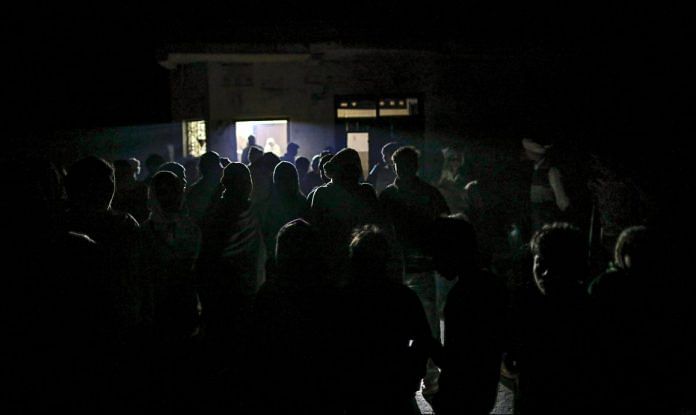The Saubhagya scheme is crawling as distribution companies lack both capacity and incentive to supply to poor households.
The ambitious ‘Saubhagya’ scheme of the Narendra Modi government aims to electrify every home in India with free or heavily subsidised connections. But in Uttar Pradesh, where 13 million households remain without power, gaps in the state government’s implementation capacity threaten to cause delay.
The basic idea behind Saubhagya is simple. Households can apply for an electricity connection that is either entirely free or heavily subsidised and paid in ten monthly instalments of Rs 50. State governments organise village camps to help households apply, and the local distribution companies provide the connections.
The Saubhagya experience in UP’s Sitapur and Bahraich
Earlier this year, the Initiative for Sustainable Energy Policy (ISEP) partnered with a Lucknow-based research company, Morsel Research & Development, to help households submit Saubhagya applications. Working in the districts of Sitapur and Bahraich in central Uttar Pradesh, our team helped hundreds of households apply for electricity connections. Both districts are critical to Saubhagya’s success, as their electrification rates (63 per cent and 52 per cent, respectively), remain below the statewide electrification rate of 66 per cent in Uttar Pradesh.
The team’s intervention helped households deal with the difficulties of the application such as photographs, identification, and proof of address. In total, 200 households submitted applications with our support.
Also read: A key hurdle to Modi’s rural electrification scheme is the paperwork
When we visited some of these households three or four months later, however, many of them still did not have electricity connections. In fact, fewer than 5 per cent of those that submitted their applications had received connections at that time.
The five household heads who we interviewed during the study visit told us that even though the distribution company accepted their application, they never heard from the officials again. No electricity connection was provided and nobody followed up with additional questions.
Several villagers told us that they had no idea what they should do and that they had given up on the hope of receiving an electricity connection any time soon.
They did not have a telephone number to call or a contact person at the local powerhouse. In one farmer’s words, “I submitted my application in February, and three months later, I still do not have a connection. I don’t know what to do or whom to call.”
Improving implementation capacity
Based on this experience, the implementation of the Saubhagya scheme could be delayed because of the lack of capacity. Even after the villagers overcome the formidable process of applications, the local distribution company does not act. This is why the scheme’s progress slows to a crawl.
The capacity problem can be solved by investing in resources and creating incentives. The total budget for the Saubhagya scheme, Rs 16,320 crore, is a modest investment when almost three crore homes remain without power. Especially poor states with many households to electrify, such as Uttar Pradesh, may lack the manpower and resources to meet the electrification demand under the scheme.
Incentives are another problem. While Saubhagya is a major political priority for Prime Minister Modi and the BJP, it remains unclear why distribution companies are not responding to his call with vigorous action. For distribution companies, electrifying and then billing poor households with limited power demand is not a profitable activity or a priority. Additional incentives, such as rewards for meeting electrification targets on time, are required.
Johannes Urpelainen is the Prince Sultan bin Abdulaziz Professor of Energy, Resources and Environment at the Johns Hopkins School of Advanced International Studies. He is also the Founding Director of the Initiative for Sustainable Energy Policy (ISEP).




Money does not grow on trees is all Dr Singh could exclaim, when faced with the wish list of the NAC. Whether it is power, gas cylinders, even the one third of a billion near dormant Jan Dhan accounts, these are essentially economic issues, where a little populism can at best be the icing on the cake. The entire power sector remains unreformed; UDAY simply kicked the can down the road for a few years, at a cost of two trillion to the state governments. 2. Sitting in our ivory towers, we do not know the success of many of these welfare oriented schemes on the ground. Official statistics are cooked like the Thanksgiving turkey. So when it is time to vote, there will be a reality check. How much benefit people have received will tell them which button to press.
Money does not grow on trees is all Dr Singh could exclaim, when faced with the wish list of the NAC. Whether it is power, gas cylinders, even the one third of a billion near dormant Jan Dhan accounts, these are essentially economic issues, where a little populism can at best be the icing on the cake. The entire power sector remains unreformed; UDAY simply kicked the can down the road for a few years, at a cost of two trillion to the state governments. 2. Sitting in our ivory towers, we do not know the success of many of these welfare oriented schemes on the ground. Official statistics are cooked like the Thanksgiving turkey. So when it is time to vote, there will be a reality check.
Modi ji doesn’t have time. He is busy in forth coming 50 rallies to annexe power again in 2019. Now, not only this scheme but all other schemes will be in back burner. Modi ji will be utilising his all skills in those tactics which could remain him in power after 2019 elections. Therefore all Indians who are not having electricity should simply keep quiet, otherwise they will be treated anti national, anti progress, pro congress or even Pakistani agents. Wah Modi Wah.